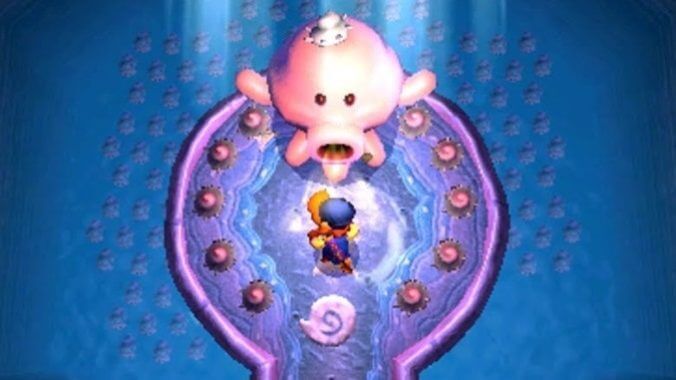I wasn’t sold on the 3DS until my friend pushed me into trying The Legend of Zelda: A Link Between Worlds. The console—a cramped, metallic blue launch 3DS—felt cheap and gimmicky; my eyes could only handle the glasses-less stereoscopic 3D for a few minutes at a time. The game itself wasn’t on my radar because, despite being part of one of my favorite franchises, I never cared for 2D Zelda. They felt limited by the lack of dimension, and as anyone who played the Game Boy / Game Boy Color entries will tell you, they were often unreasonably obtuse. So when Nintendo announced a direct sequel to the seminal A Link to the Past, I didn’t care for the slightly altered map, I didn’t want to explore the unimaginatively named kingdom of Lorule, and I wasn’t particularly charmed by seeing a chalky Link strut like an Egyptian while merged with a wall. And then I played the game, fell madly in love, and tracked down the gorgeous black and gold Link Between Worlds 3DS XL to own and cherish forever.
In the decade since it was released, I have 100% completed A Link Between World a total of three times, with a fourth attempt in progress. It’s the closest thing I have to a comfort game. Whenever the world is hectic and unrecognizable, I can always return to Hyrule and Lorule to beat some dungeons, play some baseball, and continue my lifelong obsession with surviving Cuckoo Dash for 999.99 seconds. (It’s always unfair; those fowl are foul.) The game is well known for a few things—its standout use of 3D, brilliantly designed dungeons, and a weapon rental system that laid the groundwork for the open-ended nature of Breath of the Wild—but my interest lay elsewhere.
To me, A Link Between Worlds is really Hide and Seek Simulator 3000. For the uninitiated, I’m talking about the Maiamai, the half-breed octopus/hermit crab creatures that are scattered throughout the kingdoms waiting patiently for Link to find them. The quest might seem like an annoyance to some, but Link did open their cave and let them loose so it’s his responsibility to bring them home. Collecting these critters is mandatory to get the most out of the adventure; finding all 100 Maiamai tests your understanding of the games’ mechanics and rewards you with powerful items that make combat more enjoyable than ever.
The Maiamai are easy to find, with their shrill cries cutting through Ryo Nagamatsu’s stellar score. (If you haven’t heard the Lorule Theme yet, you haven’t lived.) Getting them is often a problem: some Maiamai hide in plain sight, some shelter in trees or beneath rocks, some sit cheerfully at the bottom of rivers or mock you while resting on a cliffside without a point of entry. It’s imperative to use your knowledge of the overworld and deep understanding of the wall merge mechanic—that chalk, Picasso-esque Link that can scuttle along flat surfaces—to get all 100.
Searching every nook and cranny takes hours, but Mother Maiamai rewards you for every set of 10 found. The matriarchal crustaceopod upgrades your items one at a time, provided you own them that is. Bucking tradition, iconic Zelda items like the boomerang, bow and arrow, magic rods, and bombs are no longer found within dungeons. Instead, they must be rented from the purple-robed magical squatter, Ravio; they can be purchased outright for a higher price. Weapon rental is the defining trait of Link Between Worlds: some people love it, some hate it, but everyone agrees that its inclusion cracks the game open by allowing players to explore any of the eight Lorule dungeons in any order. It was a risky and brilliant move, and a proving ground for the truly open-world nature of Breath of the Wild and Tears of the Kingdom.
The difference between renting and ownership is significant. If you die, the rental reverts back to the landlord, I mean pawn broker, I mean sales rep. Owning the items allows you to keep them post mortem, and Mother Maiamai recognizes your right of possession by inhaling your property, swishing it around her mouth, and using her spit to enhance it into something better (and presumably, wetter). (Exactly like real life!) These Nice Upgrades are powerful: balls of fire erupt into pillars, single ice blocks and arrows multiply in triplicate, and bombs engorge into room clearing orbs of destruction. If nits were to be picked, the overpowered items do wreck some puzzles and make the game easier, but that doesn’t really matter when traipsing around the Treacherous Tower and absolutely devastating floors and floors of monsters. Even the Great Spin Attack, the screen-clearing attack that Mother Maiamai rewards you with after collecting all her spawn, is fun to use.
Sadly, once all the Maiamai are reunited, they leave for another dimension—except for the 72nd Maiamai that you saved. She stays behind to keep a little of their cephalostacean magic in Hyrule, and the real world too. Looking back at the game post–Breath of the Wild, it feels like A Link Between Worlds was the last of its kind, and I say that while rightfully ignoring the unfashionable Triforce Heroes: It’s a traditional Zelda game with handcrafted dungeons and iconic boss fights. It might’ve pushed at these constraints, but those adjustments perfected the genre that Nintendo created 27 years prior. It’s long past time for Nintendo to bring the style back, but all I ask is one teeny tiny favor: bring that 72nd Maiamai back. I need to know what she’s been up to.
Mik Deitz is a freelance writer and former Paste intern. They inhale stories in videogames, films, TV and books, and have never finished God of War (2018). Yell at or compliment them on Twitter @dietdeitz.
